Zircon U-Pb Geochronology and Hf Isotopes of the Granitoids from Cahanwusu Cu Deposit in Awulale Mountain, Western Tianshan: Implication for Regional Mineralization
Abstract
1. Introduction
2. Geologic Background
3. Geology of the Cahanwusu Cu Deposit
4. Analytical Methods
4.1. Zircon U-Pb Dating
4.2. Zircon Hf Isotope Analyses
5. Results
5.1. Zircon U-Pb Ages
5.2. Zircon Hf Isotopes
6. Discussion
6.1. New Episode of Cu Mineralization in Awulale Mountain
6.2. Tectonic Setting and Magma Sources
6.3. Implication for Regional Mineralization
7. Conclusions
Supplementary Materials
Author Contributions
Funding
Data Availability Statement
Acknowledgments
Conflicts of Interest
References
- Ge, S.; Zhai, M.; Safonova, I.; Li, D.; Zhu, X.; Zuo, P.; Shan, H. Whole-rock geochemistry and Sr–Nd–Pb isotope systematics of the Late Carboniferous volcanic rocks of the Awulale metallogenic belt in the western Tianshan Mountains (NW China): Petrogenesis and geodynamical implications. Lithos 2015, 228–229, 62–77. [Google Scholar] [CrossRef]
- Liu, R.; Chen, G. Characteristics of rare earth elements, Zr, and Hf in ore-bearing porphyries from the Western Awulale Metallogenic Belt, Northwestern China and their application in determining metal fertility of granitic magma. Resour. Geol. 2018, 69, 193–210. [Google Scholar]
- Shan, Q.; Zhang, B.; Luo, Y.; Zhou, C.P.; Yu, X.Y.; Zeng, Q.S.; Yang, W.B.; Niu, H.C. Characteristics and trace element geochemistry of pyrite from the Songhu iron deposit, Nilek County, Xinjiang, China. Acta Petrol. Sinica 2009, 25, 1456–1464. [Google Scholar]
- Wang, R.; Zhao, X.; Xue, C.; Chu, H.; Zhao, Y.; Sun, Q.; Zhu, W. Fluid evolution of the Nulasai Cu deposit, Xinjiang, NW China: Evidence from fluid inclusions and O-H-C isotopes. Ore Geol. Rev. 2024, 173, 106220. [Google Scholar]
- Zhang, Z.; Hong, W.; Jiang, Z.; Duan, S.; Li, F.; Shi, F. Geological characteristics and metallogenesis of iron deposits in western Tianshan, China. Ore Geol. Rev. 2014, 57, 425–440. [Google Scholar]
- Sun, W.; Niu, Y.; Ma, Y.; Liu, Y.; Zhang, G.; Hu, Z.; Zhang, Z.; Chen, S.; Li, J.; Wang, X.; et al. Petrogenesis of the Chagangnuoer deposit, NW China: A general model for submarine volcanic-hosted skarn iron deposits. Sci. Bull. 2015, 60, 363–379. [Google Scholar]
- Feng, J.X.; Shi, F.P.; Wang, B.Y.; Hu, J.M.; Wang, J.T.; Tian, J.Q. The Syngenetic Volcanogenic Iron ore Deposits in Awulale Metallogenetic Belt, Western Tianshan Mountains; Geological Publishing House: Beijing, China, 2010; p. 132. (In Chinese) [Google Scholar]
- Liu, R.; Chen, G. The 109 porphyry Cu deposit in the western Tianshan orogenic belt, NW China: An example of Cu mineralization in a reduced magmatichydrothermal system in an extensional setting. Ore Geol. Rev. 2019, 112, 102989. [Google Scholar]
- Zhao, X.; Xue, C.; Chi, G.; Zhao, J.; Yan, Y. Diabase-hosted copper mineralization in the Qunjsai deposit, West Tianshan, NW China: Geological, geochemical and geochronological characteristics and mineralization mechanism. Ore Geol. Rev. 2018, 92, 430–448. [Google Scholar]
- Duan, S.; Zhang, Z.; Jiang, Z.; Zhao, J.; Zhang, Y.; Li, F.; Tian, J. Geology, geochemistry, and geochronology of the Dunde iron-zinc ore deposit in western Tianshan, China. Ore Geol. Rev. 2014, 57, 441–446. [Google Scholar] [CrossRef]
- Hong, W.; Zhang, Z.; Baker, M.J.; Jiang, Z.; Duan, S. Zircon U-Pb dating and stable isotopic compositions for constraining the genesis of the Chagangnuoer magnetite deposit in western Tianshan, NW China. Ore Geol. Rev. 2020, 121, 103478. [Google Scholar]
- Jiang, Z.; Zhang, Z.; Wang, Z.; Duan, S.; Li, F.; Tian, J. Geology, geochemistry, and geochronology of the Zhibo iron deposit in the Western Tianshan, NW China: Constraints on metallogenesis and tectonic setting. Ore Geol. Rev. 2014, 57, 406–424. [Google Scholar]
- Wang, X.S.; Zhang, X.; Gao, J.; Li, J.L.; Jiang, T.; Xue, S.C. A slab break-off model for the submarine volcanic-hosted iron mineralization in the Chinese Western Tianshan: Insights from Paleozoic subduction-related to post-collisional magmatism. Ore Geol. Rev. 2018, 92, 144–160. [Google Scholar]
- Zhang, X.; Klemd, R.; Gao, J.; Dong, L.H.; Wang, X.S.; Haase, K.; Jiang, T.; Qian, Q. Metallogenesis of the Zhibo and Chagangnuoer volcanic iron oxide deposits in the Awulale Iron Metallogenic Belt, Western Tianshan orogen, China. J. Asian Earth Sci. 2015, 113, 151–172. [Google Scholar] [CrossRef]
- Zhang, X.; Tian, J.Q.; Gao, J.; Klemd, R.; Dong, L.H.; Fan, J.J.; Jiang, T.; Hu, C.J.; Qian, Q. Geochronology and geochemistry of granitoid rocks from the Zhibo syngenetic volcanogenic iron ore deposit in the Western Tianshan Mountains (NW-China): Constraints on the age of mineralization and tectonic setting. Gondwana Res. 2012, 22, 585–596. [Google Scholar]
- Windley, B.F.; Alexeiev, D.; Xiao, W.J.; Kröner, A.; Badarch, G. Tectonicmodels for accretion of the Central Asian Orogenic Belt. J. Geol. Soc. 2007, 164, 31–47. [Google Scholar]
- Gao, J.; Long, L.L.; Klemd, R.; Qian, Q.; Liu, D.Y.; Xiong, X.M.; Sun, W.; Liu, W.; Wang, Y.T.; Wang, F.Y. Tectonic evolution of the South Tianshan orogen and adjacent regions, NW China: Geochemical and age constraints of granitoid rocks. Int. J. Earth Sci. 2009, 98, 1221–1238. [Google Scholar]
- Charvet, J.; Shu, L.S.; Laurent-Charvet, S.; Wang, B.; Faure, M.; Cluzel, D.; Chen, Y.; De Jong, K. Palaeozoic tectonic evolution of the Tianshan belt, NW China. Sci. China Earth Sci. 2011, 54, 166–184. [Google Scholar]
- Xiao, W.J.; Windley, B.F.; Allen, M.B.; Han, C.M. Paleozoic multiple accretionary and collisional tectonics of the Chinese Tianshan orogenic collage. Gondwana Res. 2013, 23, 1316–1341. [Google Scholar]
- Gao, J.; Li, M.S.; Xiao, X.C.; Tang, Y.Q.; He, G.Q. Paleozoic tectonic evolution of the Tianshan Orogen northwestern China. Tectonophysics 1998, 287, 212–231. [Google Scholar]
- Li, J.L.; Su, W.; Zhang, X. Zircon Cameca U–Pb dating and its significance for granulite-facies granitic gneisses from the west Awulale Mountains, West Tianshan. Geol. Bull Chin. 2009, 28, 1852–1862, (In Chinese with English Abstract). [Google Scholar]
- Zhang, W.; Leng, C.B.; Zhang, X.C.; Su, W.C.; Tang, H.F.; Yan, J.H.; Cao, J.L. Petrogenesis of the Seleteguole granitoids from Jinhe county in Xinjiang (West China): Implications for the tectonic transformation of Northwest Tianshan. Lithos 2016, 256–257, 148–164. [Google Scholar] [CrossRef]
- Wiedenbeck, M.; Allé, P.; Corfu, F.; Griffin, W.L.; Meier, M.; Oberli, F.; Quadt, A.V.; Roddick, J.C.; Spiegel, W. Three natural zircon standards for U-Th-Pb, Lu-Hf, trace element and REE analyses. Geostand. Geoanal. Res. 1995, 19, 1–23. [Google Scholar] [CrossRef]
- Liu, Y.S.; Gao, S.; Hu, Z.C.; Gao, C.G.; Zong, K.Q.; Wang, D.B. Continental and oceanic crust recycling-induced melt-peridotite interactions in the Trans-North China orogen: U-Pb dating, Hf isotopes and trace elements in zircons of mantle xenoliths. J. Petrol. 2010, 51, 537–571. [Google Scholar] [CrossRef]
- Ludwig, K.R. User’s Manual for Isoplot 3.0: A Geochronological Toolkit for Microsoft Excel; Special Publication No 4; Berkeley Geochronology Center: Berkeley, CA, USA, 2003. [Google Scholar]
- Griffin, W.L.; Pearson, N.J.; Belousova, E.; Jackson, S.E.; van Achterbergh, E.; O’Reilly, S.Y.; Shee, S.R. The Hf isotope composition of cratonic mantle: LAM-MC-ICPMS analysis of zircon megacrysts in kimberlites. Geochim. Cosmochim. Acta 2000, 64, 133–147. [Google Scholar] [CrossRef]
- Griffin, W.L.; Wang, X.; Jackson, S.E.; Pearson, N.J.; O’Reilly, S.Y.; Xu, X.; Zhou, X. Zircon chemistry and magma mixing, SE China: In-situ analysis of Hf isotopes. Tonglu and Pingtan igneous complexes. Lithos 2002, 61, 237–269. [Google Scholar] [CrossRef]
- Belousova, E.A.; Griffin, W.L.; O’Reilly, S.Y.; Fisher, N.I. Igneous zircon, trace element composition as an indicator of source rock type. Contrib. Mineral. Petr. 2002, 143, 602–622. [Google Scholar] [CrossRef]
- Rubatto, D. Zircon trace element geochemistry: Partitioning with garnet and the link between U-Pb ages and metamorphism. Chem. Geol. 2002, 184, 123–138. [Google Scholar] [CrossRef]
- Tang, G.J.; Chung, S.L.; Wang, Q.; Wyman, D.A.; Dan, W.; Chen, H.Y.; Zhao, Z.H. Petrogenesis of a Late Carboniferous mafic dike-granitoid association in the western Tianshan: Response to the geodynamics of oceanic subduction. Lithos 2014, 202–203, 85–99. [Google Scholar] [CrossRef]
- Yan, S.; Shan, Q.; Niu, H.C.; Yang, W.B.; Li, N.B.; Zeng, L.J.; Jiang, Y.H. Petrology and geochemistry of late Carboniferous hornblende gabbro from the Awulale Mountains, western Tianshan (NW China): Implication for an arc–nascent back-arc environment. J. Asian Earth Sci. 2015, 113, 218–237. [Google Scholar] [CrossRef]
- Sun, Q.; Zhao, X.; Xue, C.; Seltmann, R.; Symons, D.T. Late Carboniferous –Early Permian mafic dikes and granitoids in the heart of the Western Tianshan Orogen, NW China: Implications for a tectonic transition from a syn- to post-collisional setting. Lithos 2021, 400–401, 106417. [Google Scholar] [CrossRef]
- Sun, Q.; Zhao, X.; Xue, C.; Seltmann, R.; McClenaghan, S.H.; Chu, H.; Wang, M. Two episodes of Late Paleozoic mafic magmatism in the western Tianshan Orogen: From Carboniferous subduction to Permian post-collisional extension. Gondwana Res. 2022, 109, 518–535. [Google Scholar]
- Seedorff, E.; Dilles, J.H.; Proffett, J.M., Jr.; Einaudi, M.T.; Zurcher, L.; Stavast, W.J.A.; Johnson, D.A.; Barton, M.D. Porphyry Deposits: Characteristics and Origin of Hypogene Features; Society of Economic Geologists: Littleton, CO, USA, 2005; pp. 251–298. [Google Scholar]
- Sillitoe, R.H. Porphyry copper systems. Econ. Geol. 2010, 105, 3–41. [Google Scholar]
- Luo, H. Geological, Geochemical Characteristics of the Nulasai Copper Deposit, Western Tian Shan, Xinjiang. Master’s Thesis, China University of Geosciences (Beijing), Beijing, China, 2016; 63p. (In Chinese with English Abstract). [Google Scholar]
- Che, Z.C.; Liu, L.; Liu, H.F.; Luo, J.H. Review on the ancient Yili rift, Xinjiang, China. Acta Petrol. Sinica 1996, 12, 478–490, (In Chinese with English Abstract). [Google Scholar]
- Gu, L.X.; Hu, S.X.; Yu, C.S.; Wu, C.Z.; Yan, Z.F. Initiation and evolution of the Bogda subduction-tore-type rift. Acta Petrologica Sinica 2001, 17, 585–597, (In Chinese with English Abstract). [Google Scholar]
- Xia, L.Q.; Xu, X.Y.; Xia, Z.C.; Li, X.; Ma, Z.P.; Wang, L.S. Petrogenesis of Carboniferous rift-related volcanic rocks in the Tianshan, northwestern China. Geol. Soc Am. Bull. 2004, 116, 419–433. [Google Scholar]
- An, F.; Zhu, Y.F.; Wei, S.N.; Lai, S.C. An Early Devonian to Early Carboniferous volcanic arc in North Tianshan, NW China: Geochronological and geochemical evidence from volcanic rocks. J. Asian Earth Sci. 2013, 78, 100–113. [Google Scholar]
- Feng, W.; Zhu, Y. Petrogenesis and tectonic implications of the late Carboniferous calc-alkaline and shoshonitic magmatic rocks in the Awulale mountain, western Tianshan. Gondwana Res. 2019, 76, 44–61. [Google Scholar]
- Gao, J.; Klemd, R. Formation of HP-LT rocks and their tectonic implications in the western Tianshan Orogen, NW China: Geochemical and age constraints. Lithos 2003, 66, 1–22. [Google Scholar]
- Long, L.; Gao, J.; Klemd, R.; Beier, C.; Qian, Q.; Zhang, X.; Wang, J.; Jiang, T. Geochemical and geochronological studies of granitoid rocks from the Western Tianshan Orogen: Implications for continental growth in the southwestern Central Asian Orogenic Belt. Lithos. 2011, 126, 321–340. [Google Scholar]
- Yang, W.B.; Niu, H.C.; Shan, Q.; Luo, Y.; Sun, W.D.; Li, C.Y.; Li, N.B.; Yu, X.Y. Late Paleozoic calc-alkaline to shoshonitic magmatism and its geodynamic implications, Yuximolegai area, western Tianshan, Xinjiang. Gondwana Res. 2012, 22, 325–340. [Google Scholar]
- Wang, M.; Zhang, J.; Zhang, B.; Liu, K.; Chen, Y.; Zheng, Y. Geochronology and geochemistry of the Borohoro pluton in the northern Yili Block, NW China: Implication for the tectonic evolution of the northern West Tianshan orogen. J. Asian Earth Sci. 2018, 153, 154–169. [Google Scholar] [CrossRef]
- Zhu, Y.F.; Zhang, L.F.; Gu, L.B.; Guo, X.; Zhou, J. The zircon SHRIMP chronology and trace element geochemistry of the Carboniferous volcanic rocks in western Tianshan Mountains. Chin. Sci. Bull. 2005, 50, 2201–2212. [Google Scholar] [CrossRef]
- Zhu, Y.F.; Guo, X.; Song, B.; Zhang, L.F.; Gu, L. Petrology, Sr-Nd-Hf isotopic geochemistry and zircon chronology of the Late Palaeozoic volcanic rocks in the southwestern Tianshan Mountains, Xinjiang, NW China. J. Geol. Soc. 2009, 166, 1085–1099. [Google Scholar] [CrossRef]
- Xiong, X.L.; Zhao, Z.H.; Bai, Z.H.; Mei, H.J.; Xu, J.F.; Wang, Q. Origin of Awulale adakitic sodium-rich rocks in western Tianshan: Constraints for Nd and Sr isotopic compositions. Acta Petrol. Sinica 2001, 17, 514–522. [Google Scholar]
- Zhao, Z.H.; Guo, Z.J.; Han, B.F.; Wang, Y. The geochemical characteristics and tectonic-magmatic implications of the latest-Paleozoic volcanic rocks from Santanghu basin, eastern Xinjiang, northwest China. Acta Petrol. Sinica 2006, 22, 199–214. [Google Scholar]
- Zhao, Z.; Xiong, X.; Wang, Q.; Bai, Z.; Qiao, Y. Late Paleozoic underplating in North Xinjiang: Evidence from shoshonites and adakites. Gondwana Res. 2009, 16, 216–226. [Google Scholar] [CrossRef]
- Cao, R.; Bagas, L.; Chen, B.; Wang, Z.; Gao, Y. Geochronology and petrogenesis of the composite Zuluhong Granite, North Xinjiang Province of China: Implications for the crust-mantle interaction and continental crustal growth in Western Tianshan Orogen. Lithos 2021, 380–381, 105837. [Google Scholar] [CrossRef]
- Chen, J.; Zhou, T.; Xie, Z.; Zhang, X.; Guo, X. Formation of positive 1 Nd(T) granitoids from the Alataw Mountains, Xinjiang, China, by mixing and fractional crystallization: Implication for Phanerozoic crustal growth. Tectonophysics 2000, 328, 53–67. [Google Scholar] [CrossRef]
- Feng, W.; Zheng, J.; Shen, P. Petrology, mineralogy, and geochemistry of the Carboniferous Katbasu Au-Cu deposit, western Tianshan, Northwest China: Implications for petrogenesis, ore genesis, and tectonic setting. Ore Geol. Rev. 2023, 161, 105659. [Google Scholar] [CrossRef]
- Han, B.; Wang, S.; Jahn, B.; Hong, D.; Kagami, H.; Sun, Y. Depleted-mantle source for the Ulungur River A-type granites from North Xinjiang, China: Geochemistry and Nd–Sr isotopic evidence, and implications for Phanerozoic crustal growth. Chem. Geol. 1997, 138, 135–159. [Google Scholar] [CrossRef]
- Jahn, B.M.; Wu, F.Y.; Hong, D.W. Important crustal growth in the Phanerozoic: Isotopic evidence of granitoids from east-central Asia. Acad. Proc. Earth Planet. Sci. 2000, 109, 5–20. [Google Scholar] [CrossRef]
- Hu, A.Q.; Jahn, B.M.; Zhang, G.X.; Zhang, Q.F. Crustal evolution and Phanerozoic crustal growth in northern Xinjiang: Nd–Sr isotopic evidence. Part I: Isotopic characterisation of basement rock. Tectonophysics 2000, 328, 15–51. [Google Scholar]
- Jahn, B.M.; Windley, B.; Natal’in, B.; Dobretsov, N. Phanerozoic continental growth in Central Asia. J. Asian Earth Sci. 2004, 23, 599–603. [Google Scholar]
- Sengör, A.M.C.; Natal’in, B.A.; Burtman, V.S. Evolution of the Altaid tectonic collage and Palaeozoic crustal growth in Eurasia. Nature 1993, 364, 298–307. [Google Scholar]
- Kröner, A.; Kovach, V.; Belousova, E.; Hegner, E.; Armstrong, R.; Dolgopolova, A.; Seltmann, R.; Alexeiev, D.V.; Hoffmann, J.E.; Wong, J.; et al. Reassessment of continental growth during the accretionary history of the Central Asian Orogenic Belt. Gondwana Res. 2014, 25, 103–125. [Google Scholar] [CrossRef]
- Hou, Z.; Yang, Z.; Qu, X.; Meng, X.; Li, Z.; Beaudoin, G.; Rui, Z.; Gao, Y.; Zaw, K. The Miocene Gangdese porphyry copper belt generated during post-collisional extension in the Tibetan Orogen. Ore Geol. Rev. 2009, 36, 25–51. [Google Scholar] [CrossRef]
- Hou, Z.Q.; Yang, Z.M.; Lu, Y.J.; Kemp, A.; Zheng, Y.C.; Li, Q.Y.; Tang, J.X.; Yang, Z.S.; Duan, L.F. A genetic linkage between subduction-continental collision-related porphyry Cu deposits in Tibet. Geology 2015, 43, 247–250. [Google Scholar]
- Richards, J.P. Magmatic to hydrothermal metal fluxes in convergent and collided margins. Ore Geol. Rev. 2011, 40, 1–26. [Google Scholar] [CrossRef]
- Liu, R.; Wang, L.X.; Chen, G.W. Genesis, geological significance and metallogentic potentiality of A-type granites in the Awulale area of the western Tianshan, Xinjiang. Acta Petrol. Sinica 2017, 33, 1741–1751, (In Chinese with English Abstract). [Google Scholar]
- Zhao, Z.H.; Xiong, X.L.; Wang, Q.; Bai, Z.H.; Mei, H.J. A case study on porphyry Cu deposit related with adakitic quartz albite porphyry in Mosizaote, Western Tianshan, Xinjiang, China. Acta Petrol. Sinica 2004, 20, 249–258, (In Chinese with English Abstract). [Google Scholar]
- Li, N.B.; Niu, H.C.; Shan, Q.; Yang, W.B. Two episodes of Late Paleozoic A-type magmatism in the Qunjisayi area, western Tianshan: Petrogenesis and tectonic implications. J. Asian Earth Sci. 2015, 113, 238–253. [Google Scholar] [CrossRef]
- Cooke, D.R.; Hollings, P.; Walshe, J.L. Giant porphyry deposits: Characteristics, distribution, and tectonic Controls. Econ. Geol. 2005, 100, 801–818. [Google Scholar] [CrossRef]
- Candela, P.A.; Piccoli, P.M. Magmatic Processes in the Development of Porphyry-Type Ore Systems; Society of Economic Geologists: Littleton, CO, USA, 2005; pp. 25–37. [Google Scholar]

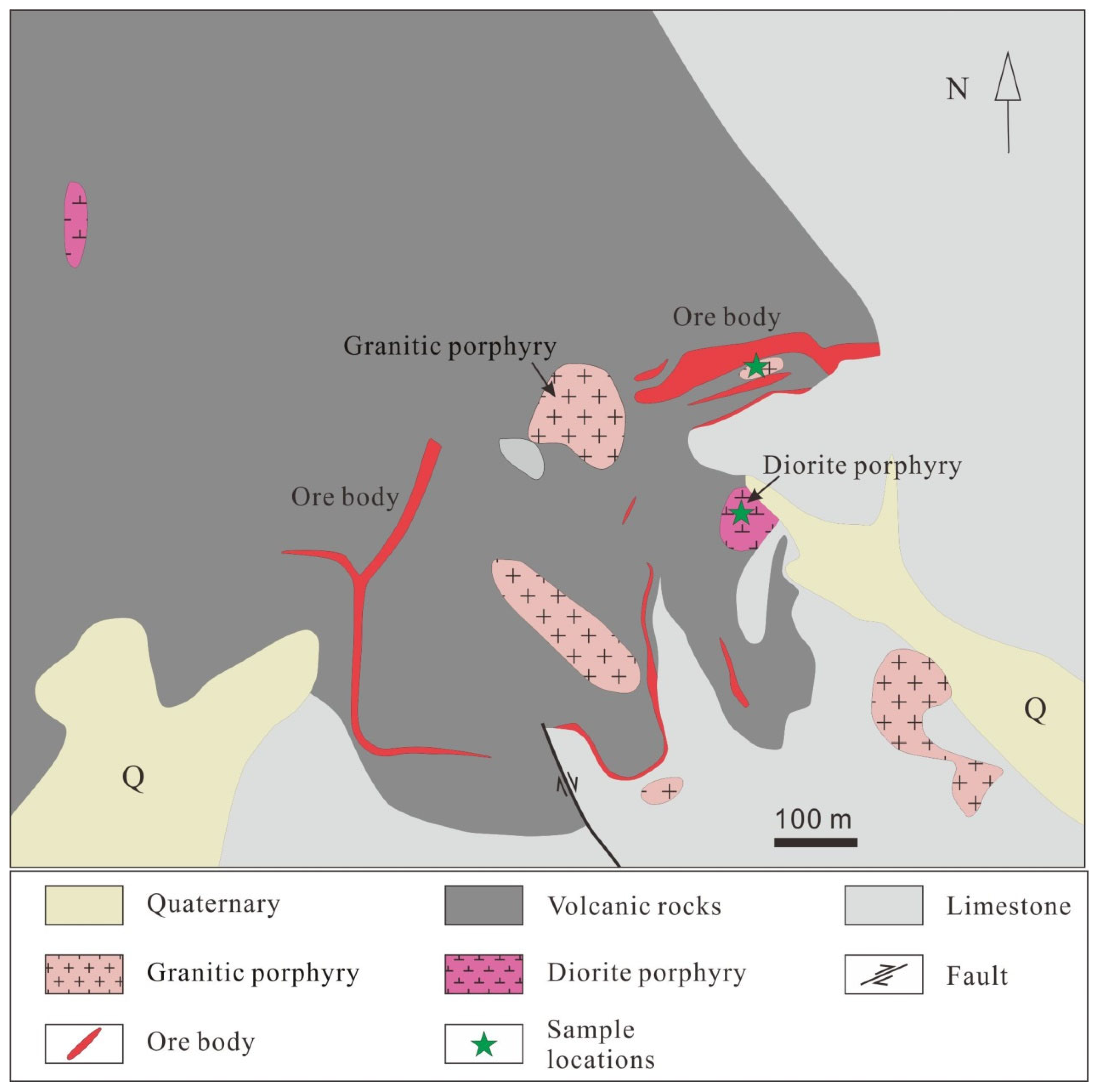
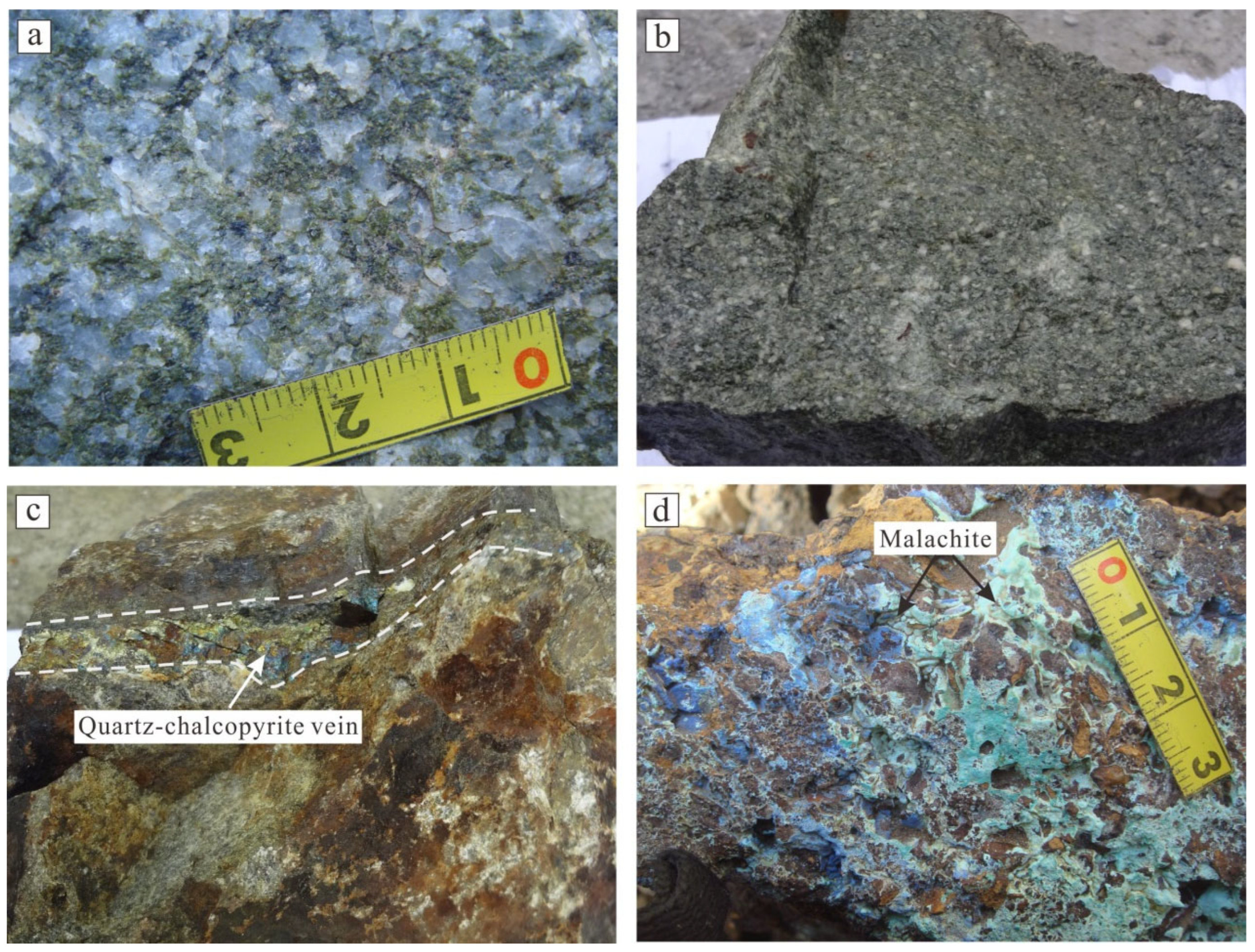
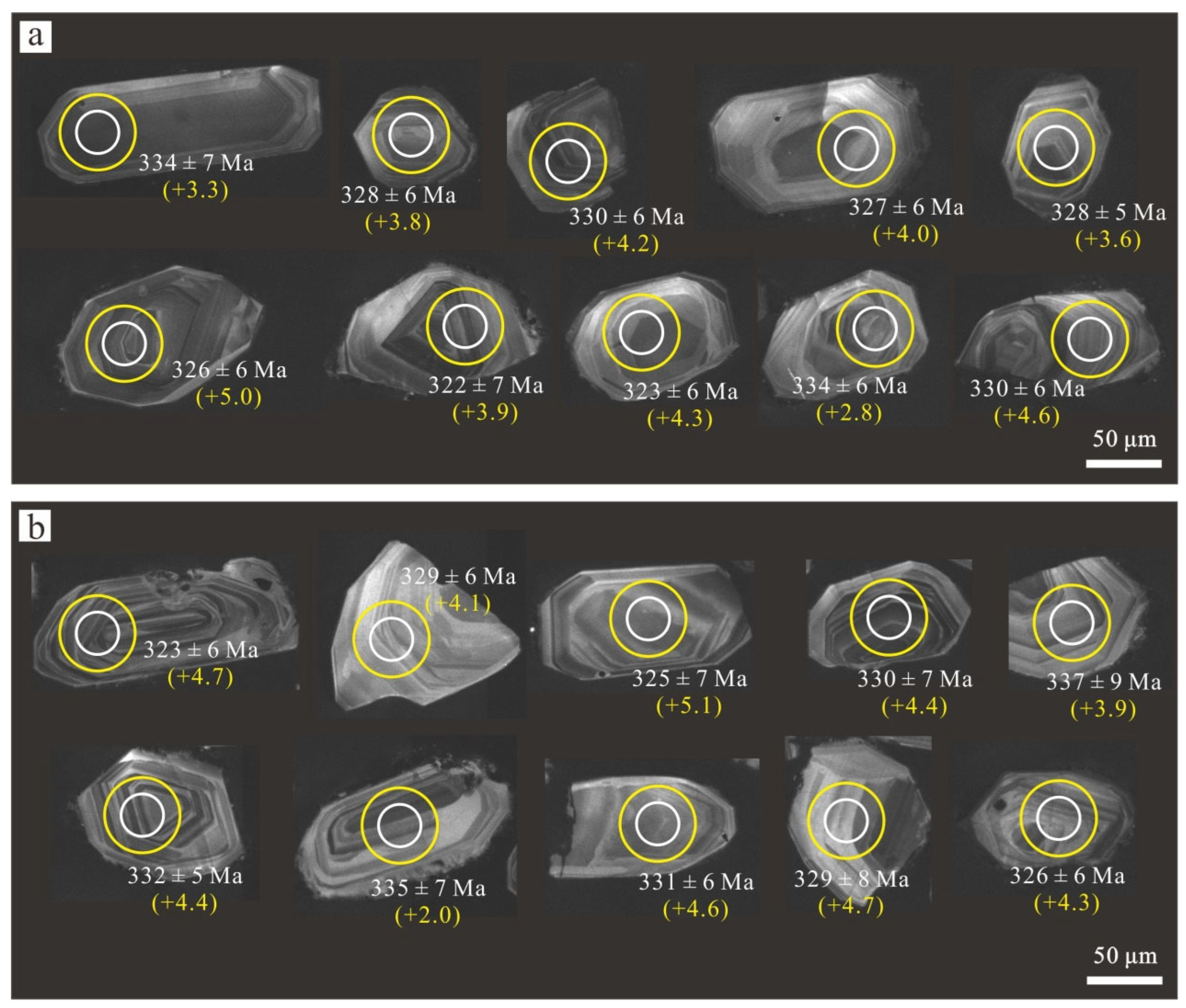
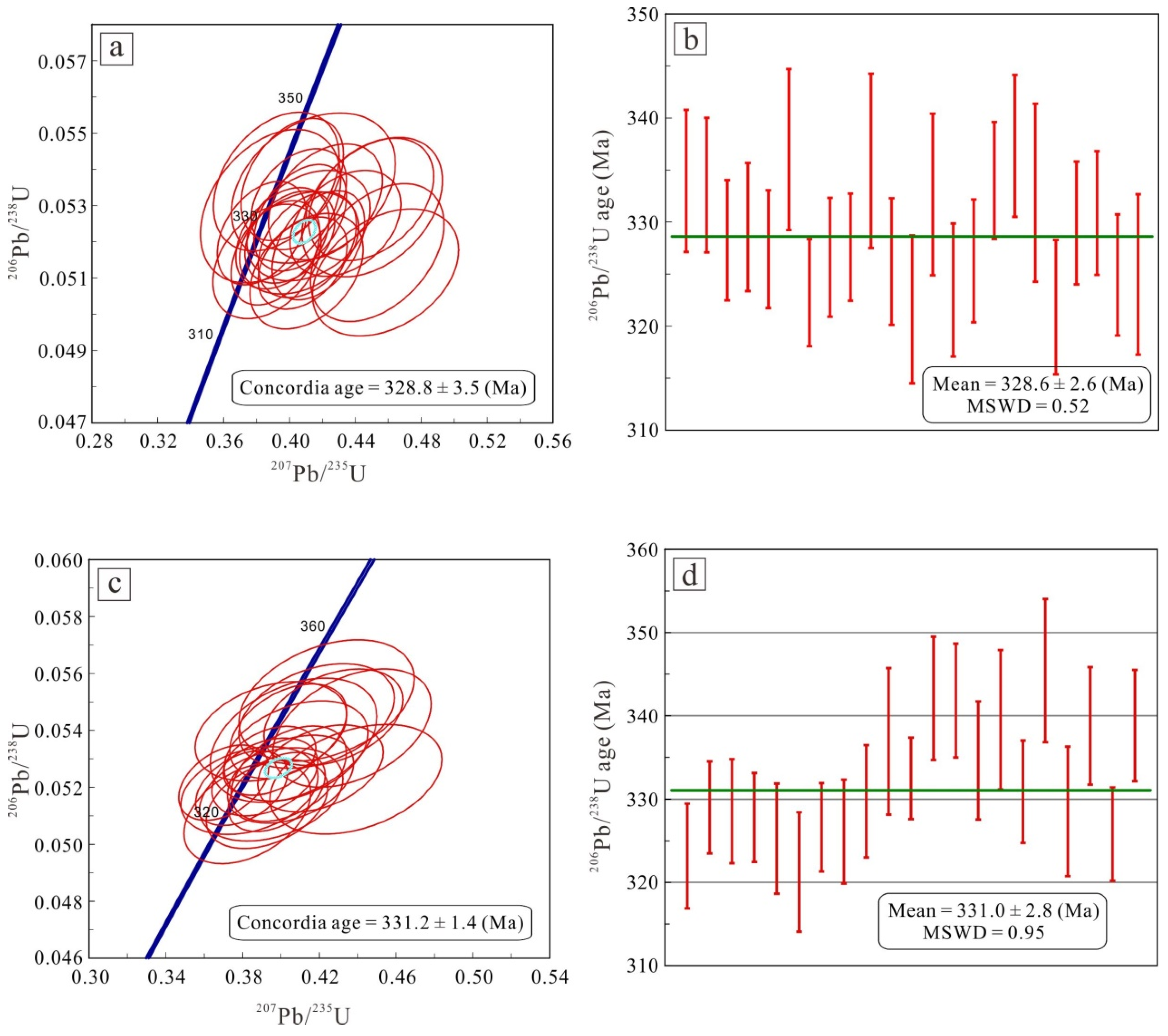
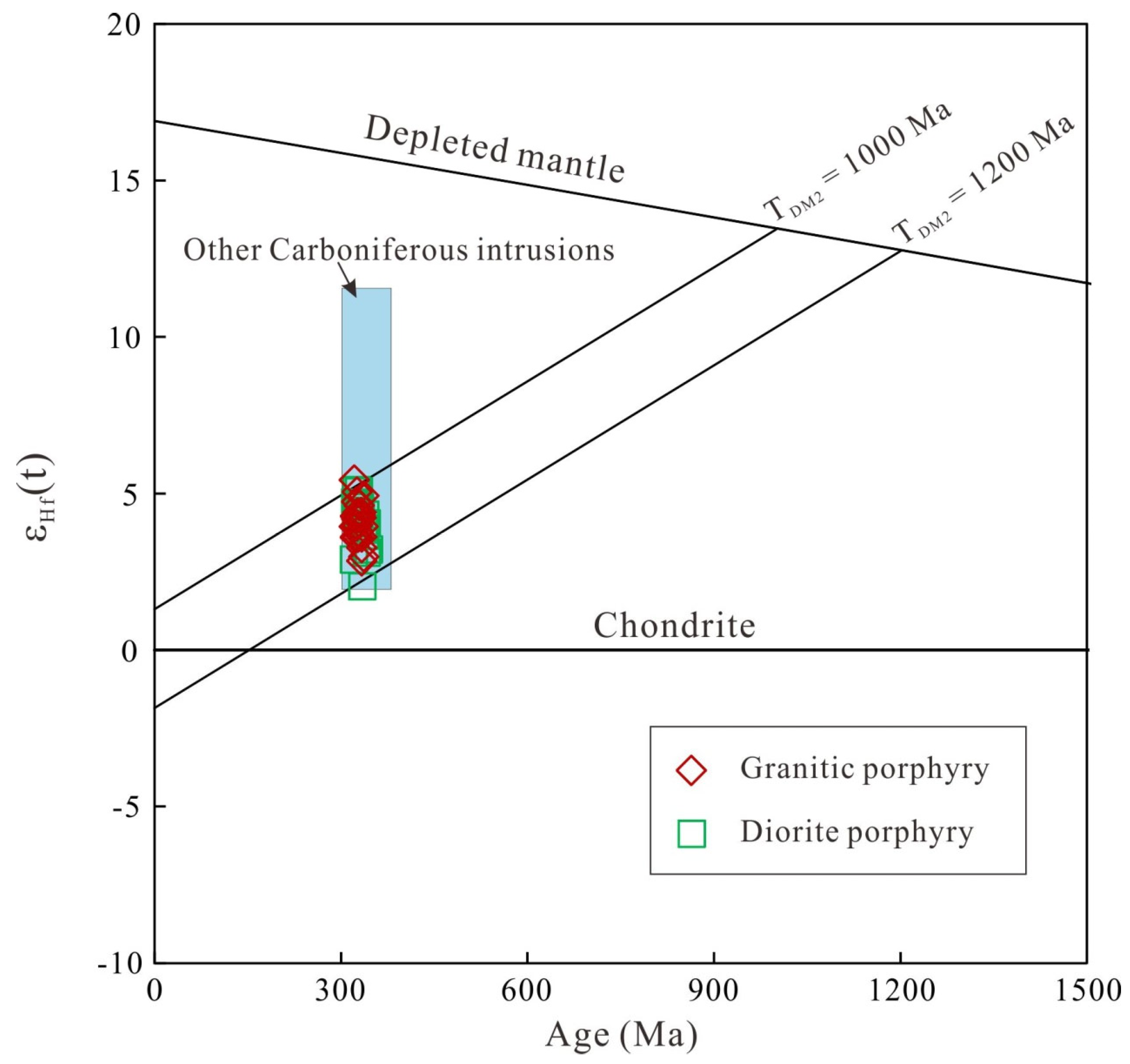
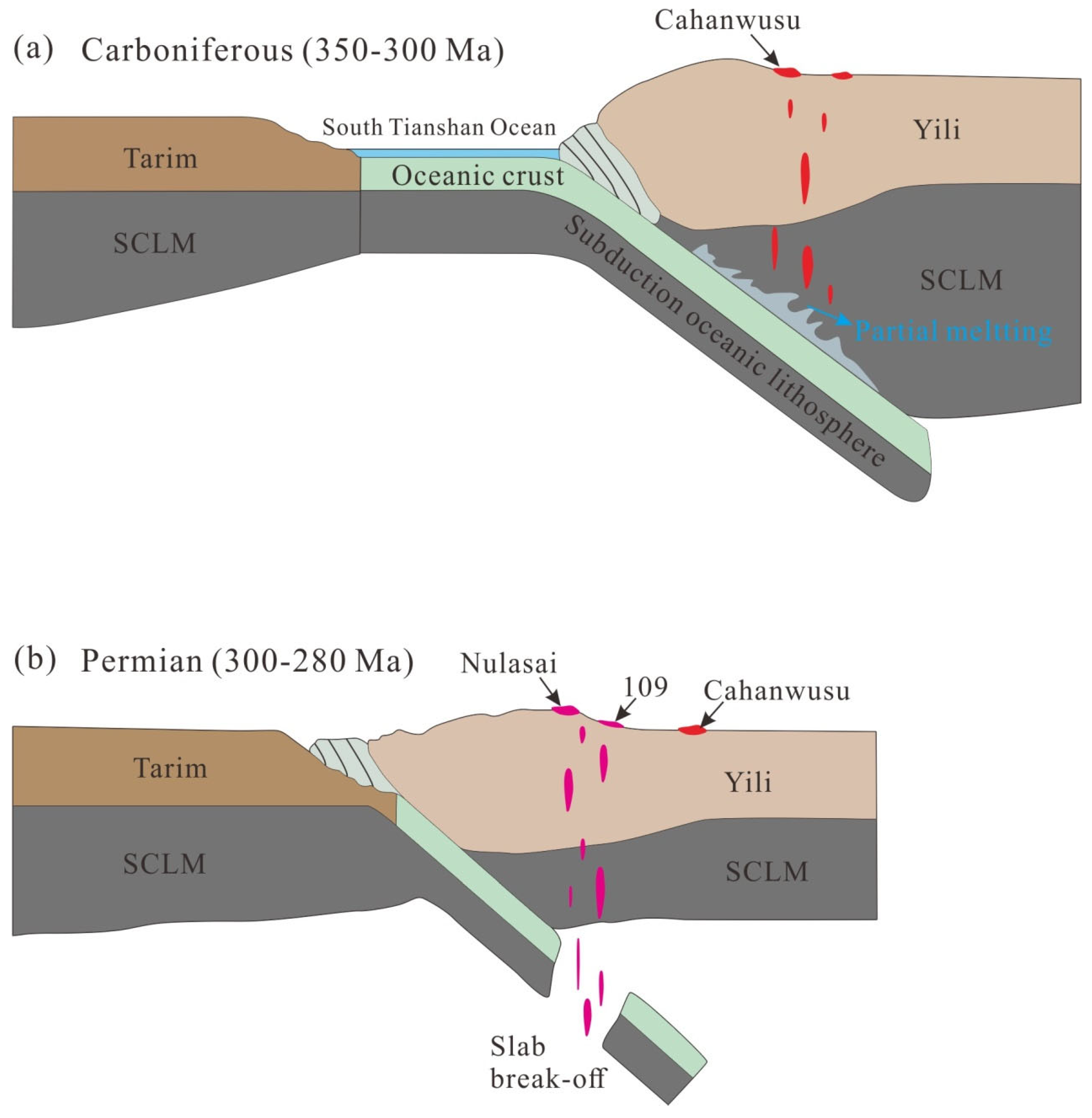
| Spots | Th (ppm) | U (ppm) | Th/U | 207Pb/206Pb | 207Pb/235U | 206Pb/238U | 207Pb/206Pb | 207Pb/235U | 206Pb/238U | Concordance | ||||||
|---|---|---|---|---|---|---|---|---|---|---|---|---|---|---|---|---|
| Ratio | 1sigma | Ratio | 1sigma | Ratio | 1sigma | Age | 1sigma | Age | 1sigma | Age | 1sigma | |||||
| Granitic Porphyry | ||||||||||||||||
| CH12-01 | 325 | 693 | 0.47 | 0.0597 | 0.0036 | 0.4496 | 0.0251 | 0.0532 | 0.0011 | 594 | 131 | 377 | 17.5 | 334 | 6.83 | 97% |
| CH12-02 | 355 | 611 | 0.58 | 0.0570 | 0.0034 | 0.4218 | 0.0228 | 0.0531 | 0.0011 | 500 | 131 | 357 | 16.3 | 334 | 6.47 | 95% |
| CH12-03 | 350 | 751 | 0.47 | 0.0528 | 0.0028 | 0.3832 | 0.0178 | 0.0522 | 0.0009 | 320 | 122 | 329 | 13.1 | 328 | 5.77 | 99% |
| CH12-04 | 244 | 518 | 0.47 | 0.0555 | 0.0032 | 0.4116 | 0.0247 | 0.0524 | 0.0010 | 435 | 134 | 350 | 17.8 | 330 | 6.16 | 98% |
| CH12-05 | 234 | 673 | 0.35 | 0.0540 | 0.0026 | 0.3957 | 0.0187 | 0.0521 | 0.0009 | 369 | 109 | 339 | 13.6 | 327 | 5.66 | 96% |
| CH12-06 | 179 | 321 | 0.56 | 0.0531 | 0.0036 | 0.3920 | 0.0252 | 0.0537 | 0.0013 | 332 | 154 | 336 | 18.4 | 337 | 7.73 | 99% |
| CH12-07 | 560 | 916 | 0.61 | 0.0569 | 0.0027 | 0.4080 | 0.0179 | 0.0514 | 0.0008 | 487 | 99.1 | 347 | 12.9 | 323 | 5.15 | 96% |
| CH12-09 | 283 | 634 | 0.45 | 0.0551 | 0.0032 | 0.4059 | 0.0239 | 0.0520 | 0.0009 | 417 | 128 | 346 | 17.3 | 327 | 5.71 | 94% |
| CH12-10 | 562 | 914 | 0.61 | 0.0546 | 0.0025 | 0.4003 | 0.0180 | 0.0521 | 0.0008 | 394 | 97.2 | 342 | 13.1 | 328 | 5.15 | 95% |
| CH12-11 | 125 | 257 | 0.48 | 0.0589 | 0.0056 | 0.4146 | 0.0328 | 0.0535 | 0.0014 | 565 | 208 | 352 | 23.5 | 336 | 8.37 | 95% |
| CH12-12 | 381 | 722 | 0.53 | 0.0577 | 0.0027 | 0.4175 | 0.0185 | 0.0519 | 0.0010 | 517 | 102 | 354 | 13.3 | 326 | 6.09 | 97% |
| CH12-14 | 264 | 504 | 0.52 | 0.0647 | 0.0043 | 0.4583 | 0.0293 | 0.0512 | 0.0012 | 765 | 142 | 383 | 20.4 | 322 | 7.10 | 96% |
| CH12-15 | 168 | 382 | 0.44 | 0.0601 | 0.0037 | 0.4503 | 0.0282 | 0.0530 | 0.0013 | 606 | 140 | 377 | 19.7 | 333 | 7.77 | 97% |
| CH12-16 | 208 | 470 | 0.44 | 0.0538 | 0.0033 | 0.3864 | 0.0217 | 0.0515 | 0.0010 | 365 | 141 | 332 | 15.9 | 323 | 6.40 | 97% |
| CH12-17 | 279 | 593 | 0.47 | 0.0564 | 0.0029 | 0.4108 | 0.0197 | 0.0519 | 0.0010 | 465 | 113 | 349 | 14.2 | 326 | 5.90 | 93% |
| CH12-18 | 292 | 648 | 0.45 | 0.0537 | 0.0026 | 0.4058 | 0.0191 | 0.0532 | 0.0009 | 367 | 105 | 346 | 13.8 | 334 | 5.62 | 96% |
| CH12-19 | 349 | 641 | 0.55 | 0.0531 | 0.0029 | 0.4017 | 0.0205 | 0.0537 | 0.0011 | 332 | 121 | 343 | 14.9 | 337 | 6.81 | 98% |
| CH12-20 | 104 | 272 | 0.38 | 0.0518 | 0.0038 | 0.3886 | 0.0281 | 0.0530 | 0.0014 | 280 | 167 | 333 | 20.6 | 333 | 8.56 | 99% |
| CH12-22 | 427 | 555 | 0.77 | 0.0565 | 0.0032 | 0.4103 | 0.0227 | 0.0512 | 0.0011 | 472 | 124 | 349 | 16.3 | 322 | 6.46 | 93% |
| CH12-23 | 367 | 554 | 0.66 | 0.0583 | 0.0031 | 0.4340 | 0.0222 | 0.0525 | 0.0010 | 543 | 110 | 366 | 15.7 | 330 | 5.91 | 98% |
| CH12-24 | 685 | 734 | 0.93 | 0.0546 | 0.0027 | 0.4066 | 0.0185 | 0.0527 | 0.0010 | 394 | 109 | 346 | 13.4 | 331 | 5.94 | 95% |
| CH12-25 | 374 | 763 | 0.49 | 0.0536 | 0.0026 | 0.3915 | 0.0177 | 0.0517 | 0.0009 | 354 | 107 | 335 | 12.9 | 325 | 5.82 | 96% |
| CH12-26 | 135 | 362 | 0.37 | 0.0624 | 0.0038 | 0.4533 | 0.0267 | 0.0517 | 0.0013 | 687 | 130 | 380 | 18.7 | 325 | 7.70 | 95% |
| Diorite porphyry | ||||||||||||||||
| CH15-01 | 180 | 278 | 0.6467 | 0.0541 | 0.0031 | 0.3928 | 0.0209 | 0.0514 | 0.0010 | 376 | 128 | 336 | 15.2 | 323 | 6.3 | 97% |
| CH15-02 | 313 | 422 | 0.7413 | 0.0543 | 0.0026 | 0.3916 | 0.0182 | 0.0524 | 0.0009 | 383 | 107 | 336 | 13.3 | 329 | 5.5 | 98% |
| CH15-03 | 157 | 318 | 0.4950 | 0.0568 | 0.0032 | 0.4050 | 0.0217 | 0.0523 | 0.0010 | 483 | 129 | 345 | 15.7 | 329 | 6.2 | 96% |
| CH15-04 | 364 | 490 | 0.7425 | 0.0513 | 0.0022 | 0.3702 | 0.0155 | 0.0522 | 0.0009 | 254 | 100 | 320 | 11.5 | 328 | 5.3 | 97% |
| CH15-05 | 116 | 181 | 0.6377 | 0.0556 | 0.0036 | 0.3949 | 0.0247 | 0.0517 | 0.0011 | 435 | 146 | 338 | 18.0 | 325 | 6.6 | 96% |
| CH15-06 | 97.3 | 195 | 0.4984 | 0.0541 | 0.0032 | 0.3825 | 0.0218 | 0.0511 | 0.0012 | 376 | 135 | 329 | 16.0 | 321 | 7.2 | 97% |
| CH15-08 | 600 | 644 | 0.9308 | 0.0513 | 0.0022 | 0.3795 | 0.0158 | 0.0520 | 0.0009 | 254 | 98.1 | 327 | 11.6 | 327 | 5.3 | 99% |
| CH15-09 | 151 | 240 | 0.6264 | 0.0533 | 0.0036 | 0.3836 | 0.0236 | 0.0519 | 0.0010 | 339 | 147 | 330 | 17.3 | 326 | 6.2 | 98% |
| CH15-10 | 190 | 318 | 0.5965 | 0.0553 | 0.0028 | 0.4041 | 0.0198 | 0.0525 | 0.0011 | 433 | 147 | 345 | 14.3 | 330 | 6.7 | 95% |
| CH15-11 | 57.2 | 125 | 0.4573 | 0.0573 | 0.0049 | 0.4066 | 0.0287 | 0.0537 | 0.0014 | 502 | 189 | 346 | 20.7 | 337 | 8.8 | 97% |
| CH15-13 | 406 | 510 | 0.7964 | 0.0533 | 0.0023 | 0.3941 | 0.0159 | 0.0529 | 0.0008 | 339 | 98.1 | 337 | 11.6 | 332 | 4.9 | 98% |
| CH15-14 | 87.8 | 174 | 0.5054 | 0.0550 | 0.0036 | 0.4185 | 0.0267 | 0.0545 | 0.0012 | 413 | 146 | 355 | 19.1 | 342 | 7.4 | 96% |
| CH15-15 | 142 | 255 | 0.5559 | 0.0577 | 0.0036 | 0.4273 | 0.0239 | 0.0545 | 0.0011 | 520 | 137 | 361 | 17.0 | 342 | 6.8 | 94% |
| CH15-16 | 130 | 235 | 0.5544 | 0.0557 | 0.0037 | 0.4079 | 0.0248 | 0.0533 | 0.0012 | 443 | 148 | 347 | 17.9 | 335 | 7.1 | 96% |
| CH15-17 | 94.4 | 183 | 0.5165 | 0.0593 | 0.0041 | 0.4371 | 0.0272 | 0.0541 | 0.0014 | 589 | 145 | 368 | 19.2 | 340 | 8.4 | 98% |
| CH15-19 | 177 | 285 | 0.6213 | 0.0590 | 0.0034 | 0.4206 | 0.0216 | 0.0527 | 0.0010 | 565 | 126 | 356 | 15.4 | 331 | 6.1 | 97% |
| CH15-20 | 76.1 | 146 | 0.5193 | 0.0578 | 0.0045 | 0.4238 | 0.0301 | 0.0550 | 0.0014 | 524 | 174 | 359 | 21.5 | 345 | 8.6 | 96% |
| CH15-21 | 67.3 | 127 | 0.5303 | 0.0657 | 0.0054 | 0.4391 | 0.0296 | 0.0523 | 0.0013 | 798 | 174 | 370 | 20.9 | 329 | 7.8 | 98% |
| CH15-22 | 119 | 182 | 0.6542 | 0.0531 | 0.0037 | 0.3948 | 0.0261 | 0.0540 | 0.0012 | 345 | 157 | 338 | 19.0 | 339 | 7.1 | 99% |
| CH15-23 | 237 | 488 | 0.4860 | 0.0555 | 0.0025 | 0.3978 | 0.0167 | 0.0518 | 0.0009 | 432 | 98.1 | 340 | 12.1 | 326 | 5.6 | 95% |
| CH15-24 | 193 | 360 | 0.5366 | 0.0540 | 0.0028 | 0.4038 | 0.0201 | 0.0540 | 0.0011 | 372 | 119 | 344 | 14.6 | 339 | 6.7 | 98% |
| Spots | 176Lu/177Hf | 1σ | 176Hf/177Hf | 1σ | εHf(t) | 1σ | TDM1 | 1σ | TDM2 | 1σ |
|---|---|---|---|---|---|---|---|---|---|---|
| Granitic Porphyry | ||||||||||
| CH12-01 | 0.001403 | 0.000010 | 0.282669 | 0.000018 | 3.26 | 0.64 | 835 | 25.7 | 1128 | 40.4 |
| CH12-02 | 0.001606 | 0.000087 | 0.282680 | 0.000017 | 3.60 | 0.60 | 824 | 24.5 | 1106 | 38.2 |
| CH12-03 | 0.001168 | 0.000016 | 0.282682 | 0.000018 | 3.77 | 0.64 | 812 | 25.5 | 1096 | 40.4 |
| CH12-04 | 0.001018 | 0.000010 | 0.282694 | 0.000016 | 4.23 | 0.57 | 792 | 22.6 | 1067 | 35.9 |
| CH12-05 | 0.001135 | 0.000003 | 0.282699 | 0.000016 | 4.38 | 0.57 | 787 | 22.7 | 1057 | 35.9 |
| CH12-06 | 0.001293 | 0.000034 | 0.282660 | 0.000011 | 2.96 | 0.39 | 846 | 15.7 | 1147 | 24.7 |
| CH12-07 | 0.001359 | 0.000013 | 0.282678 | 0.000018 | 3.59 | 0.64 | 822 | 25.7 | 1107 | 40.4 |
| CH12-09 | 0.001334 | 0.000022 | 0.282689 | 0.000017 | 3.98 | 0.60 | 805 | 24.2 | 1082 | 38.2 |
| CH12-10 | 0.001491 | 0.000018 | 0.282679 | 0.000019 | 3.59 | 0.67 | 823 | 27.2 | 1107 | 42.6 |
| CH12-11 | 0.001388 | 0.000011 | 0.282688 | 0.000018 | 3.94 | 0.64 | 808 | 25.7 | 1085 | 40.4 |
| CH12-12 | 0.001535 | 0.000025 | 0.282720 | 0.000021 | 5.04 | 0.74 | 765 | 30.1 | 1015 | 47.2 |
| CH12-14 | 0.001058 | 0.000017 | 0.282686 | 0.000019 | 3.94 | 0.67 | 804 | 26.9 | 1085 | 42.7 |
| CH12-15 | 0.001384 | 0.000056 | 0.282696 | 0.000018 | 4.22 | 0.64 | 797 | 25.7 | 1067 | 40.4 |
| CH12-16 | 0.000990 | 0.000026 | 0.282695 | 0.000012 | 4.27 | 0.42 | 790 | 17.0 | 1064 | 27.0 |
| CH12-17 | 0.001237 | 0.000009 | 0.282687 | 0.000022 | 3.95 | 0.78 | 806 | 31.3 | 1085 | 49.4 |
| CH12-18 | 0.001832 | 0.000035 | 0.282659 | 0.000018 | 2.83 | 0.64 | 860 | 26.0 | 1156 | 40.4 |
| CH12-19 | 0.001041 | 0.000002 | 0.282713 | 0.000019 | 4.92 | 0.67 | 765 | 26.9 | 1024 | 42.7 |
| CH12-20 | 0.001347 | 0.000075 | 0.282700 | 0.000015 | 4.39 | 0.53 | 790 | 21.4 | 1057 | 33.7 |
| CH12-22 | 0.001003 | 0.000038 | 0.282727 | 0.000014 | 5.42 | 0.50 | 745 | 19.8 | 992 | 31.5 |
| CH12-23 | 0.001152 | 0.000012 | 0.282705 | 0.000018 | 4.61 | 0.64 | 779 | 25.5 | 1043 | 40.5 |
| CH12-24 | 0.001255 | 0.000012 | 0.282697 | 0.000016 | 4.30 | 0.57 | 792 | 22.8 | 1063 | 35.9 |
| CH12-25 | 0.001733 | 0.000030 | 0.282712 | 0.000017 | 4.73 | 0.60 | 781 | 24.5 | 1036 | 38.2 |
| CH12-26 | 0.001641 | 0.000063 | 0.282696 | 0.000019 | 4.18 | 0.67 | 802 | 27.3 | 1070 | 42.7 |
| Diorite Porphyry | ||||||||||
| CH15-01 | 0.001253 | 0.000005 | 0.282707 | 0.000019 | 4.70 | 0.67 | 778 | 27.0 | 1039 | 42.7 |
| CH15-02 | 0.002497 | 0.000180 | 0.282725 | 0.000016 | 5.07 | 0.57 | 778 | 23.9 | 1016 | 36.1 |
| CH15-03 | 0.001476 | 0.000026 | 0.282692 | 0.000018 | 4.12 | 0.64 | 804 | 25.8 | 1076 | 40.4 |
| CH15-04 | 0.001392 | 0.000006 | 0.282695 | 0.000020 | 4.25 | 0.71 | 798 | 28.5 | 1068 | 44.9 |
| CH15-05 | 0.001217 | 0.000004 | 0.282718 | 0.000014 | 5.10 | 0.50 | 762 | 19.9 | 1014 | 31.5 |
| CH15-06 | 0.001352 | 0.000043 | 0.282656 | 0.000016 | 2.87 | 0.57 | 853 | 22.8 | 1155 | 35.9 |
| CH15-08 | 0.002171 | 0.000140 | 0.282699 | 0.000016 | 4.22 | 0.57 | 809 | 23.5 | 1070 | 36.0 |
| CH15-09 | 0.001465 | 0.000020 | 0.282706 | 0.000012 | 4.62 | 0.42 | 784 | 17.2 | 1044 | 27.0 |
| CH15-10 | 0.001126 | 0.000003 | 0.282697 | 0.000020 | 4.37 | 0.71 | 790 | 28.3 | 1060 | 44.9 |
| CH15-11 | 0.001149 | 0.000004 | 0.282683 | 0.000014 | 3.87 | 0.50 | 810 | 19.8 | 1092 | 31.4 |
| CH15-13 | 0.001150 | 0.000004 | 0.282699 | 0.000013 | 4.44 | 0.46 | 787 | 18.4 | 1056 | 29.2 |
| CH15-14 | 0.001118 | 0.000006 | 0.282661 | 0.000019 | 3.10 | 0.67 | 840 | 26.9 | 1140 | 42.6 |
| CH15-15 | 0.001203 | 0.000018 | 0.282688 | 0.000015 | 4.04 | 0.53 | 804 | 21.3 | 1081 | 33.7 |
| CH15-16 | 0.002177 | 0.000065 | 0.282637 | 0.000018 | 2.02 | 0.64 | 900 | 26.3 | 1209 | 40.3 |
| CH15-17 | 0.001253 | 0.000012 | 0.282696 | 0.000018 | 4.31 | 0.64 | 794 | 25.6 | 1064 | 40.4 |
| CH15-19 | 0.000946 | 0.000006 | 0.282701 | 0.000019 | 4.56 | 0.67 | 780 | 26.8 | 1048 | 42.7 |
| CH15-20 | 0.000825 | 0.000010 | 0.282662 | 0.000017 | 3.20 | 0.60 | 833 | 23.9 | 1134 | 38.1 |
| CH15-21 | 0.001016 | 0.000013 | 0.282705 | 0.000024 | 4.68 | 0.85 | 776 | 33.9 | 1040 | 53.9 |
| CH15-22 | 0.001241 | 0.000006 | 0.282677 | 0.000014 | 3.64 | 0.50 | 821 | 19.9 | 1106 | 31.4 |
| CH15-23 | 0.001360 | 0.000021 | 0.282695 | 0.000013 | 4.25 | 0.46 | 797 | 18.5 | 1068 | 29.2 |
| CH15-24 | 0.001603 | 0.000030 | 0.282685 | 0.000016 | 3.85 | 0.57 | 817 | 23.0 | 1093 | 35.9 |
Disclaimer/Publisher’s Note: The statements, opinions and data contained in all publications are solely those of the individual author(s) and contributor(s) and not of MDPI and/or the editor(s). MDPI and/or the editor(s) disclaim responsibility for any injury to people or property resulting from any ideas, methods, instructions or products referred to in the content. |
© 2025 by the authors. Licensee MDPI, Basel, Switzerland. This article is an open access article distributed under the terms and conditions of the Creative Commons Attribution (CC BY) license (https://creativecommons.org/licenses/by/4.0/).
Share and Cite
Zhang, W.; Chen, M.-X.; Yang, M.-L.; Yang, W.-H.; Zhang, X.-C. Zircon U-Pb Geochronology and Hf Isotopes of the Granitoids from Cahanwusu Cu Deposit in Awulale Mountain, Western Tianshan: Implication for Regional Mineralization. Minerals 2025, 15, 380. https://doi.org/10.3390/min15040380
Zhang W, Chen M-X, Yang M-L, Yang W-H, Zhang X-C. Zircon U-Pb Geochronology and Hf Isotopes of the Granitoids from Cahanwusu Cu Deposit in Awulale Mountain, Western Tianshan: Implication for Regional Mineralization. Minerals. 2025; 15(4):380. https://doi.org/10.3390/min15040380
Chicago/Turabian StyleZhang, Wei, Mao-Xue Chen, Mei-Li Yang, Wen-Hui Yang, and Xing-Chun Zhang. 2025. "Zircon U-Pb Geochronology and Hf Isotopes of the Granitoids from Cahanwusu Cu Deposit in Awulale Mountain, Western Tianshan: Implication for Regional Mineralization" Minerals 15, no. 4: 380. https://doi.org/10.3390/min15040380
APA StyleZhang, W., Chen, M.-X., Yang, M.-L., Yang, W.-H., & Zhang, X.-C. (2025). Zircon U-Pb Geochronology and Hf Isotopes of the Granitoids from Cahanwusu Cu Deposit in Awulale Mountain, Western Tianshan: Implication for Regional Mineralization. Minerals, 15(4), 380. https://doi.org/10.3390/min15040380






